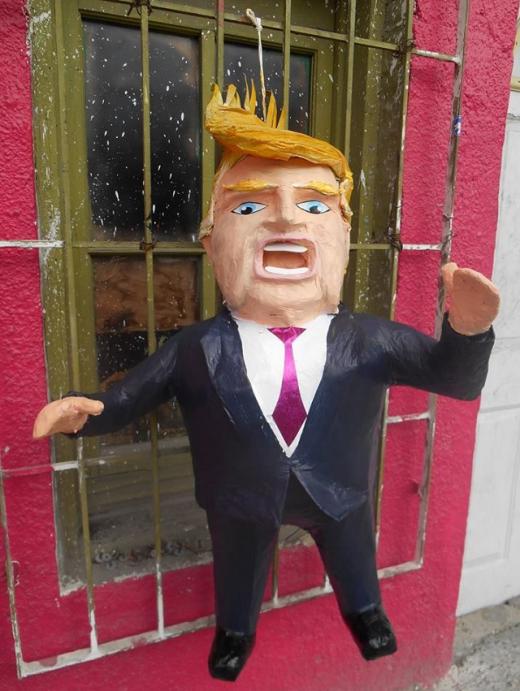
The Carnaval parade in Chapala, Mexico is a grand colorful affair, and this year a new character livened up the festivities: Donald Trump.
A YouTube video of the event shows a lively nighttime parade marching through the streets. There are Star Wars characters on stilts and lit up with lights, dancing women in sparkling bikinis, and numerous floats. Then a jester in a spade-patterned suit produces a large paper mâché doll, the effigy is none other than Donald Trump. The dummy has the infamous coiffed yellow hair and is wearing a dark suit with a red tie and a white shirt. The jester passes the Trump effigy off to a Mexican wrestler wearing a silver face mask who proceeds to body slam the presidential contender against the pavement, to great cheers and jeers from the crowd. In true WWF fashion, the wrestler then hoists Trump high above his head, to more cheers and jeers. An announcer in the crowd says something in Spanish, then Trump is placed in a golden coffin—actually a large beer cooler wrapped in gold foil—and a jug of greenish yellowish liquid is produced, presumably some sort of fuel. After rallying the crowd up, the wrestler pours the liquid onto the Trump effigy, and with a defiant flick, the jester tosses a match into the cooler. Woosh, Trump goes up in flames. Critics of the real estate tycoon and presidential candidate back in the United States might be cheering at this point too, and although the burning of a Trump effigy in Chapala certainly has political overtones, it is also part of a storied tradition that goes back 500 years. The word effigy comes from the Latin word meaning representation, and the first figures were used in funerals and burials and served as representations of the recently deceased. These effigies were often made of stone or metal (designed to weather eternity), and were placed in a supine position on top of tombs. Other less permanent effigies were made of softer materials, like wax, and often dressed in real clothing. The most common British effigy example is probably that of Guy Fawkes, the infamous British conspirator who in 1605 plotted to assassinate King James I of England and restore a Catholic monarch to the throne. Fawkes and his conspirators were caught, tortured and hung to death, then drawn and quartered—although Fawkes actually fell from the scaffold and broke his neck, sparing him the horrific true intent of the punishment, which involves being emasculated, disemboweled, beheaded and chopped into four pieces, to be displayed in prominent places across the country, such as the London Bridge. Needless to say, the British have invented an entire holiday for the occasion; it falls on November 5, and is called Guy Fawkes Night. Immediately after Fawkes death, the day became a popular celebration, rife with religious overtones. Anti-Catholic sentiments ran high, and much to the consternation of religious leaders, popular religious figures were burnt in effigy, including the Pope. At some point in the 18th Century, it seems that Guy Fawkes effigies, often hawked by children, began being burnt as well. Throughout the nineteenth century, the holiday was a scene of incredible violence, but these days’ bonfires and fireworks are the norm. The political effigy may have begun in Britain, but it has become widely popular in the United States too. One of the more famous recent effigy incidents occurred eight years ago in West Hollywood, when ChadMichael Morrisette, a professional window display designer, set up a life-size mannequin of Sarah Palin hanging from a noose off the side of his house. The effigy drew the attention of the Los Angeles County Sheriff’s Department, the Secret Service, and the National Organization of Women. “It is a shock to the senses for those of us who work to stop violence against women to see such a public depiction of violence,” said President Kim Gandy, at the time. “This has no place in civilized dialogue.” Effigies happen elsewhere too. Just last week activists in South Korea held an anti-North Korea rally in Seoul and then burnt North Korean leader Kim Jong Un in effigy. “Our people and the international community strongly condemn the long-range missile launch and the fourth nuclear test by Kim Jong Un,” said one rally-goer. “We call for strong sanctions including…cutting off electric power and water.” Meanwhile, Donald Trump is still hot on the campaign trail, and back in Chapala, Mexico, the crowds, presumably, are still jeering.









